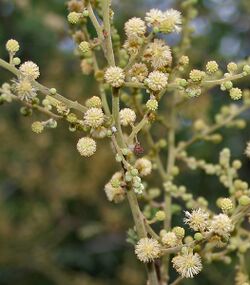Biology:Vachellia leucophloea
| Vachellia leucophloea | |
|---|---|

| |
| Flowering in Vanasthalipuram, Hyderabad | |
| Scientific classification | |
| Kingdom: | Plantae |
| Clade: | Tracheophytes |
| Clade: | Angiosperms |
| Clade: | Eudicots |
| Clade: | Rosids |
| Order: | Fabales |
| Family: | Fabaceae |
| Subfamily: | Caesalpinioideae |
| Clade: | Mimosoid clade |
| Genus: | Vachellia |
| Species: | V. leucophloea
|
| Binomial name | |
| Vachellia leucophloea (Roxb.) Maslin, Seigler & Ebinger
| |
| Varieties | |
| |
| Synonyms | |
| |
Vachellia leucophloea (Hindi: रेवंजा), also called reonja, is a moderate-sized tree native to South and Southeast Asia.[1]
Distribution
Vachellia leucophloea grows natively in India, Nepal, Pakistan, Sri Lanka, Myanmar, Thailand, Vietnam, and Indonesia.[1]
Medicinal uses
The bark extracts of Vachellia leucophloea are used in Pakistani traditional medicine as an astringent, a bitter, a thermogenic, a styptic, a preventive of infections, an anthelmintic, a vulnerary, a demulcent, an expectorant, an antipyretic, an antidote for snake bites and in the treatment of bronchitis, cough, vomiting, wounds, ulcers, diarrhea, dysentery, internal and external hemorrhages, dental caries, stomatitis, and intermittent fevers and skin diseases.[2] An ethanolic extract ointment has shown marked wound healing activity in trials.[3]
Culinary uses
The bark is used to prepare a spirit from sugar and palm juice, and in times of scarcity it is ground and mixed with flour. The pods are used as a vegetable, and the seeds can be ground and mixed with flour.[4]
Other uses
The wood is sometimes used to make attractive furniture and other implements, though it can be difficult to work with and is not durable.[5]
References
| Wikimedia Commons has media related to Vachellia leucophloea. |
- ↑ 1.0 1.1 "Acacia leucophloea (Roxb.) Willd.". http://www.proseanet.org/prosea/e-prosea_detail.php?frt=&id=1386.
- ↑ Imran Imran, Liaqat Hussain, M. Zia-Ul-Haq, Khalid Hussain Janbaz, Anwar H. Gilani, Vincenzo De Feo, "Gastrointestial and respiratory activities of Acacia leucophloea." Journal of Ethnopharmacology Volume 138, Issue 3: Pages 676-682.
- ↑ Suriyamoorthy, Sembian; Subramaniam, Kalidass; Wahab, Femina; Karthikeyan, G (December 2012). "Evaluation of wound healing activity of Acacia leucophloea bark in rats". Revista Brasileira de Farmacognosia 22 (6): 1338–1343. doi:10.1590/S0102-695X2012005000121.
- ↑ Sturtevant's notes on edible plants. 1919. p. 19. https://archive.org/details/sturtevantsnotes00sturuoft.
- ↑ "ACACIA LEUCOPHLOEA – SHADE AND FODDER FOR LIVESTOCK IN AND ENVIRONMENTS". https://www.winrock.org/factnet-a-lasting-impact/fact-sheets/acacia-leucophloea-shade-and-fodder-for-livestock-in-and-environments/.
- R N Kaul (1963): Need for afforestation in the arid zones of India, LA-YAARAN, Vol 13
- R C Ghosh (1977): Hand book on afforestation techniques, Dehradun.
- R K Gupta & Ishwar Prakasah (1975): Environmental analysis of the Thar Desert, Dehradun.
Wikidata ☰ Q3595658 entry
 |

